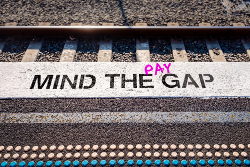March 2020
Authors : Thomas Breda, Paul Dutronc-Postel, Joyce Sultan, Maxime Tô
Contact : thomas.breda@ens.fr, paul.dutronc@ipp.eu
Main funders : Rights, Equality and Citizenship Program of the European Union 2014-2020 (GenPensGap project – 820786)
…………………………
 Gender inequality within Firms: what does the professional equality index measure?
Gender inequality within Firms: what does the professional equality index measure?
Summary:
In 2016, in private companies with 50 or more employees, the average hourly wage of women was 19% lower than that of men. When the effect of age and socioprofessional categories is considered, the resulting pay gap is 12%. In September 2018, the French government introduced a set of measures aimed at reducing these inequalities. Among these, all private companies with more than 50 employees must calculate and publish the professional equality index from March 1st, 2020. Companies must reach a minimum value on this index, or expose themselves to sanctions. The index combines several indicators, each relating to an important aspect of professional inequalities between men and women, with calculations based on the professional situation of men and women employed in companies. Using administrative data, we roughly calculate the indicators that constitute the index for all French companies and offer an overview of the extent of professional gender inequalities at company level. We also document the effects of certain methodological choices used to calculate the index, and suggest possible alternatives. These alternatives could improve the identification of companies with high gender inequalities.
Key points:
- There are large disparities between companies in terms of professional gender inequalities. In 50% of companies with 50 or more employees, women earn on average at least 5.8% less than men.
- 15.2% of companies have no women among their 10 highest hourly earners. 17.9% have only one.
- The rate of wage increase for women is on average lower than for men. These average results, however, conceal wide disparities between companies.
- Despite the inclusion of several dimensions of inequality, the index could be improved: for example, by considering the overall representation of men and women in the firm.
- By making ad hoc corrections, the index tends to underestimate pay inequalities, and provides no incentive to reduce them within groups of employees for which they are less than 5%.
Ce message est également disponible en :  French
French



